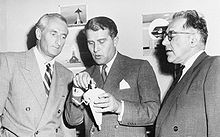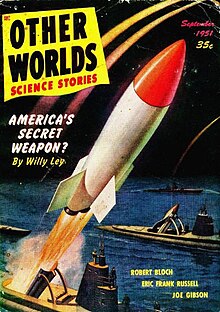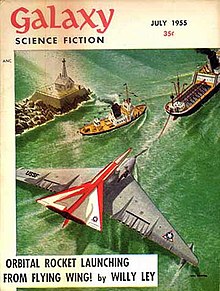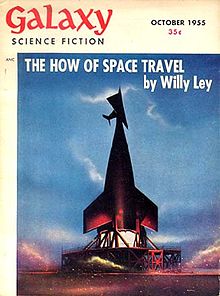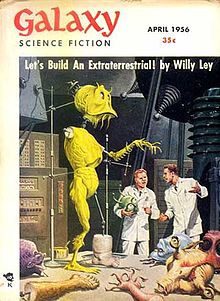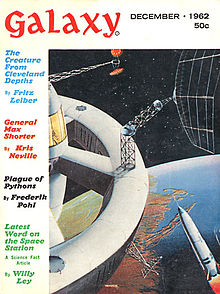Early life and Berlin years
Willy Otto Oskar Ley was the son of Julius Otto Ley, a traveling merchant, and Frida May, the daughter of a Lutheran sexton. Ley grew up in his native Berlin during the First World War under the supervision of two aunts. When war erupted his father was in Great Britain. Consequently, he spent the remainder of the war at a detention camp on the Isle of Man. Meanwhile, his mother worked as milliner in a distant city in Germany.
As Ley later recalled he "grew up, so to speak, in the shadow of the Museum of Natural History in Berlin". When his school teacher asked him to compose an essay on the subject "What Do I Want to Be When I Am Grown and Why?", Ley responded: "I want to be an explorer." His teacher thought this silly, but Ley was unconvinced.
At the University of Berlin, he studied astronomy, physics, zoology and paleontology. Ley explained, "I was never quite sure whether my studies would earn me the title of 'zoologist' or 'geologist', but I kept exploring, in a manner of speaking, looking especially into such corners as others had neglected." He then became interested in spaceflight after reading Hermann Oberth's book Die Rakete zu den Planetenräumen (The Rocket into Interplanetary Space). Although it was a difficult technical book, Ley worked through the calculations and concluded that outer space would soon become the next great frontier of human exploration. Ley was so convinced by Oberth's book that he sat down at the age of 19 to write a popularization of its contents. He also began corresponding with every known rocket enthusiast in Europe, including Oberth himself. After publishing Die Fahrt ins Weltall (Travel in Outer Space) in 1926, Ley became one of the first members of Germany's amateur rocket group, the Verein für Raumschiffahrt (VfR – "Spaceflight Society") in 1927 and wrote extensively for its journal, Die Rakete (The Rocket). Ley would eventually become the group's Vice-President during a time when it had no active President. Meanwhile, he was writing hundreds of short articles about rockets for German and foreign newspapers.
Due to the influence of Ley and other popular science writers, such as Max Valier, Germans witnessed a short-lived "rocketry fad" in Berlin. From exhibits at public locations to large spectator events, such as Fritz von Opel's rocket-car stunts, the German public was excited about both the future possibilities of space travel and the potential for new "weapons of wonder" that could revive the German Empire.
The "rocketry fad" culminated with Fritz Lang's 1929 film Die Frau im Mond (Woman in the Moon), which became the first realistic depiction of spaceflight in cinematic history. Although Oberth is often credited as the main technical consultant to the film, Ley's role was of central importance. Oberth was tasked with building a small rocket to be launched at the film's premiere. This project never materialized. However, Ley's work on the movie did. As director Fritz Lang later recalled, "The work he had done as consultant and advisor ... was amazing. The models of the spaceship, really a highly advanced model of a rocket, the trajectories and the orbits of the modular capsule from the earth, around the earth and to the moon and back ... were so accurate that in 1937 the Gestapo confiscated not only all models of the spaceship but also all foreign prints of the picture."
Despite the many successes the "rocketry fad" could not be sustained during the early years of the Great Depression. The German public lost interest amidst economic turmoil. Meanwhile, some rocket researchers formed closer ties with the military, which greatly expanded under the leadership of Wernher von Braun. With the collapse of the VfR, the rise of a culture of necessary secrecy and the loss of public enthusiasm, Ley grew discouraged. He continued to write articles for the domestic and foreign press while he stayed in touch with close friends. Yet for the most part, Ley turned back to his original scientific interests, while writing a biography of Conrad Gessner (the "father" of modern zoology). To make ends meet, Ley also worked as a clerk and then manager at a Berlin bank.
When the Nazis seized power, Ley's situation became increasingly desperate. He was horrified by National Socialism, its ideology and its style of violent politics. His perception of political events can be inferred from a short science fiction story "Fog", which Ley wrote in 1940 under the pen name of Robert Wiley. It is a biographical narrative about an office manager dealing with the everyday effects of totalitarianism. Although the story is set in New York City during a failed Communist revolution, it is clear that Ley is retelling his personal experiences in Berlin. In fact, John Campbell, the editor of Astounding, requested that Ley center the narrative on his personal experience. Ley not only disliked the irrational nature of German politics, but he also associated the Nazis with the rise of "Pseudo-science". To make matters worse, Ley had an established reputation as an international scientist, who openly shared and popularized technical information about rocketry, while his articles continued to be republished by foreign newspapers throughout 1934.
In January 1935, Ley used company stationery to write a letter that authorized his vacation in London. Carrying only his favorite books, a few changes of clothing and travel documentation, Ley fled Germany for the United Kingdom and ultimately the United States.
